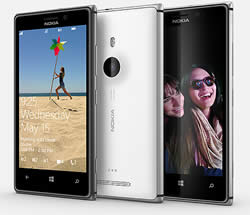Difference between Nokia Lumia 925 and LG Optimus G Pro
Key Difference: Nokia has recently announced its new flagship phone the Nokia Lumia 925. The phone comes with a 4.5-inch AMOLED capacitive touch screen which takes up a good amount of space on the front, with the speaker and sensors on the top. The 4.5-inch capacitive screen has the same PureMotion HD+, ClearBlack that is found in Lumia 920. LG Optimus G Pro has major updates to its predecessor, the LG Optimus G. The device sports a massive 5.5-inch True Full HD IPS touch screen with multi-touch capability and a pixel density of 401 ppi. Under the hood, the phone is powered by 1.7 GHz Quad-core Snapdragon 600, making it pretty fast and speedy.
 Nokia has recently announced its new flagship phone the Nokia Lumia 925. This phone is in lines with the other new Nokia Lumia 928, but differs from its cousin in many ways. The Nokia Lumia 925 was also known as “Catwalk” phone for a long time before it was officially announced. The company has maintained a similar design to its Lumia phones but has added a metal band. This is the first phone that will feature a mix of plastic and metal. However, the back is still made of polycarbonate plastic. The phone is made slim and light weight making it comfortable to hold. The phone’s frame is made of aluminum with only the back made of plastic. However, the back is non-removable so the battery is not easily accessible.
Nokia has recently announced its new flagship phone the Nokia Lumia 925. This phone is in lines with the other new Nokia Lumia 928, but differs from its cousin in many ways. The Nokia Lumia 925 was also known as “Catwalk” phone for a long time before it was officially announced. The company has maintained a similar design to its Lumia phones but has added a metal band. This is the first phone that will feature a mix of plastic and metal. However, the back is still made of polycarbonate plastic. The phone is made slim and light weight making it comfortable to hold. The phone’s frame is made of aluminum with only the back made of plastic. However, the back is non-removable so the battery is not easily accessible.
The device is available in black, white or grey, so don’t look for the bright colors that are expected of other Nokia phones. The phones comes with a 4.5-inch AMOLED capacitive touch screen which takes up a good amount of space on the front, with the speaker and sensors on the top and the three capacitive buttons (Home, Back and Menu) on the bottom. Similar to the other high-end Lumias, the top of the device holds audio jack, the microUSB port and the SIM slot. The left and the bottom side of the device is bare, while the right side has the volume rocker, the power button and the dedicated camera button making it a little too crowded.
The 4.5-inch capacitive screen has the same PureMotion HD+, ClearBlack that is found in Lumia 920. The ClearBlack technology plus the HD OLED screen offers sharp, clear images and also spectacular viewing in sunlight. The phones provides a good contrast and vibrant colors but the difference is not really that apparent when using day-to-day.
Under the hood, the phone is powered by Dual-core 1.5 GHz Krait Qualcomm MSM8960 Snapdragon, the same processor used in Lumia 920 and 928. The processor is fast and responsive, but lags when it comes to camera. The phone comes with Adreno 225 and 1 GB RAM, compared to the 2G found in its competitors. The phone comes with only 16 GB internal memory and does not offer users to extend it using an external card. The phone integrates the Windows Phone 8 OS, which works seamlessly. However, again similar to all other Windows Phones, the app stores lack many apps and still has yet to reach its potential.
The phone comes with an 8.7MP rear camera and a 1.3MP front camera. The camera comes with upgraded technology that uses a 1/3'' sensor size to take more high-res photos. The camera also comes with Nokia’s Smart Camera technology that allows taking 10 photos at once, which can then be altered to create the perfect photo. This is similar to the Zoe technology found on HTC One that takes mini videos along with photos. The company has also added an additional lens on the five-lens that allows taking much better photos. Nokia also boasts about its low-light imaging technology that allows users to take excellent photos in low-lighting conditions. The imaging technology is quite superior and does take excellent images with less blur. However, the camera shutter is quite slow which requires the user to hold the phone with a steady hand to eliminate motion blur.
The company also has removed the built-in wireless feature to cut down on the weight, but has added it as an option by purchasing the wireless cover. The phone comes with a non-removable Li-Ion 2000 mAh battery that allows the phone to go longer periods of time without requiring charging. The phone also comes with a few nifty features that make it stand out. The new phone is slick, thin and has decent features. It could just be phone that turns the tide in favor of Nokia Windows Phone.

The LG Optimus G Pro is the successor to the original LG Optimus G and resembles the Samsung Galaxy Note II in size
and features. The phone has already been announced and launched in Korea, with launch date yet to be released for the rest of the world.
The LG Optimus G Pro has major updates to its predecessor, the LG Optimus G. The device sports a massive 5.5-inch True Full HD IPS touch screen with multi-touch capability and a pixel density of 401 ppi. The screen is truly amazing in viewing and the bigger screen is perfect for multi-purpose use (things people usually whip out their tablets or laptops for). The high resolution ensures crisp and sharp images, while the phone has great viewing angles. The large screen also ensures that the device is hard to hold and function with one hand. The G Pro has a sleek plastic chassis, which makes it a slippery when trying to maneuver single-handedly. However, the plastic chassis does not make the phone weak; in fact it is very resilient. LG has made it a bit easier by placing the power and the volume buttons on the right side of the device, rather than placing the power button on the top. Operating the phone requires the person holds the phone in one hand and operates using the other.
Under the hood, the phone is powered by 1.7 GHz Quad-core Snapdragon 600, making it pretty fast and speedy. The device can handle running multiple operations as well as high-res games, without major glitches. The device offers internal memory capacity of 32 GB, which can be expanded further using the microSD slot by 64 GB. The device provides 2 GB worth of RAM, decreasing the lagging effect when running too many apps. The device comes with an NFC, Infrared port, USB and Wi-Fi hotspot capability. The Infrared port ensures that the phone can be made into a remote for any supporting device, while the hot-spot allows the person to share internet with others.
The device houses a 13 MP primary camera for picture taking that supports 4208 x 3120 pixels, and a 2.1 MP secondary camera for video conferencing or calls. The camera is pretty decent in terms of taking hi-res, sharp photos, however, according to The Verge review; the camera has a tendency of washing out colors from the images. The huge viewfinder on the device is great for taking images. Both the cameras have the ability to take videos at 1080p@30fps. One pretty nifty feature on the phone is the Dual-recording feature (similar to the one on the S4), which allows the user to record videos simultaneously from both of the camera. Another feature that is boasted by the company is the Virtual Reality Panorama shot that allows the user to take images and stitch them together for 360 degree panorama shots (this feature is very similar to the Photo Shoot on the Nexus 4).
The device houses a massive Li-Po 3140 mAh battery that is removable, a must feature for many smartphone lovers. The company has yet to release the official data about the Talktime and the Stand-by time offered by the phone. LG has also added the QSlide apps and the QButton feature on the phone. The QSlide apps are widgets that allow the user to do multiple jobs on the same screen, such as take notes, see the calendar, check e-mail and can also allow the user to watch a video and text at the same time. A similar feature is available in the Note II, but it the system only allows the user to access limited apps on the phone. The QButton located on the left side of the device allows the user to access any apps on the phone by pressing the button. The device is yet to hit other shores and prices will also be announced accordingly with the release dates.
The information for the detailed table about the two phones has been taken from the Nokia website, theverge.com, engadget.com and GSMArena.com.
|
|
Nokia Lumia 925 |
LG Optimus G Pro |
|
Launch Date |
June 2013 |
Q2/2013 |
|
Company |
Nokia |
LG |
|
Size |
129 x 70.6 x 8.5 mm |
150.2 x 76.1 x 9.4 mm |
|
Display |
4.5 inches AMOLED capacitive touchscreen |
5.5 inches True Full HD IPS Plus LCD capacitive touchscreen |
|
Screen |
768 x 1280 pixels (~334 ppi pixel density), 16M colors |
1080 x 1920 pixels (~401 ppi pixel density) |
|
Protection |
Corning Gorilla Glass 2 |
N/A |
|
Weight |
139 grams |
172 grams |
|
2G Network |
GSM 850 / 900 / 1800 / 1900 |
GSM 850 / 900 / 1800 / 1900 |
|
3G Network |
HSDPA 850 / 900 / 1900 / 2100 - RM-892, RM-893 HSDPA 850 / 900 / 1700 / 1900 / 2100 - RM-910 |
HSDPA 900 / 2100 |
|
4G Network |
LTE 800 / 900 / 1800 / 2100 / 2600 - RM-892 LTE 700 / 1700 / 2100 - RM-893 |
Depends on market availability |
|
GUI |
Windows Phone 8 |
LG Optimus UI |
|
CPU speed |
Dual-core 1.5 GHz Krait |
1.7 GHz Quad-core Snapdragon 600 |
|
GPU |
Adreno 225 |
Adreno 320 |
|
OS |
Windows Phone 8 |
Android v4.1.2 (Jelly Bean) |
|
Chipset |
Qualcomm MSM8960 Snapdragon |
Qualcomm APQ8064T Snapdragon 600 |
|
RAM |
1 GB |
2 GB |
|
SIM Size |
microSIM |
microSIM |
|
Internal Memory |
16 GB |
32 GB |
|
Expandable Memory |
N/A |
Up to 64 GB |
|
Sensors |
Ambient light sensor, Accelerometer, Gyroscope, Proximity sensor, Magnetometer, Orientation sensor |
Accelerometer, gyro, proximity, compass |
|
Connectivity |
SIM, microUSB, 3.5mm audio, USB, Bluetooth, Wi-Fi, NFC, Wi-Fi Channel bonding |
2G, 3G, 4G, Wi-Fi, Bluetooth, NFC, Infrared port, DLNA, Wi-Fi hotspot, USB, USB Host. |
|
Data |
GPRS, EDGE, WLAN, Bluetooth, NFC and USB. |
GPRS, EDGE, WLAN, Bluetooth, NFC, Infrared port, USB. |
|
Speed |
HSDPA, 42.2 Mbps; HSUPA, 5.76 Mbps; LTE, Cat3, 50 Mbps UL, 100 Mbps DL |
HSDPA, HSUPA, LTE |
|
WLAN |
WLAN IEEE 802.11 a/b/g/n |
Wi-Fi 802.11 a/b/g/n/ac, dual-band, Wi-Fi Direct, DLNA, Wi-Fi hotspot |
|
Bluetooth |
Bluetooth v3.0 with A2DP; Object Push profile (OPP) 1.1, Hands-free profile (HFP) 1.5, Advanced Audio Distribution Profile (A2DP) 1.2, Audio/Video Remote Control Profile (AVRCP) 1.4, Phone Book Access Profile (PBAP) 1.1 |
Bluetooth v4.0 with A2DP |
|
USB |
microUSB v2.0 |
microUSB v2.0 (MHL), USB Host |
|
Primary Camera |
8.7 MP, 3264 x 2448 pixels |
13 MP, 4208 x 3120 pixels |
|
Secondary Camera |
1.3 MP, 720p@30fps |
2.1 MP, 1080p@30fps |
|
Video |
1080p@30fps, video stabilization |
1080p@30fps Dual-video recording HDR |
|
Camera Features |
|
|
|
Sound Enhancement |
Dolby Headphone sound enhancement Active noise cancellation with dedicated mic |
Dolby mobile sound enhancement |
|
Audio supported formats |
ASF, MP4, AAC, AMR, MP3, M4A, WMA, 3GP, 3G2 |
MP3/ WMA/ WAV/ FLAC/ eAAC+/ AC3 player |
|
Video supported formats |
MP4, WMV, AVI, 3GP, 3G2, M4V, MOV |
MP4/ H.264/ H.263/ WMV/ DviX player |
|
Battery Capacity |
Non-removable Li-Ion 2000 mAh battery (BL-4YW) |
Removable Li-Po 3140 mAh |
|
Talktime |
2G: 18 hours 3G: 12 hours |
No official data released |
|
Standby Time |
3G: 440 hours |
No official data released |
|
Available Colors |
Black, White, Gray |
Black, White |
|
Messaging |
SMS (threaded view), MMS, Email, Push Email, IM |
SMS(threaded view), MMS, Email, Push Mail, IM, RSS |
|
Browser |
HTML5 |
HTML5, Adobe Flash |
|
Radio |
FM radio |
Stereo FM radio with RDS |
|
GPS |
GPS with A-GPS support and GLONASS |
GPS with A-GPS support and GLONASS |
|
Java |
N/A |
Java MIDP emulator |
|
Additional Features |
|
|
Image Courtesy: nokia.com, engadget.com









Add new comment